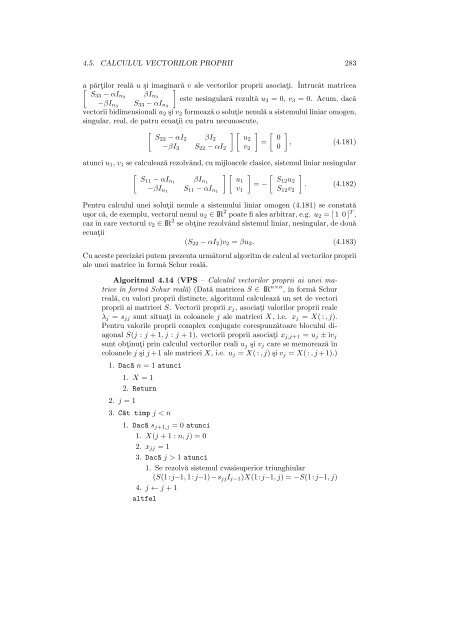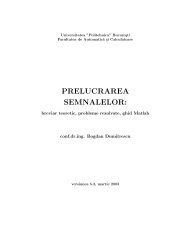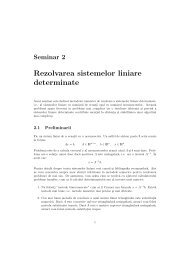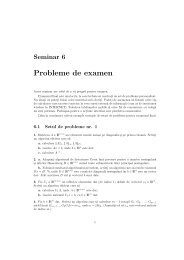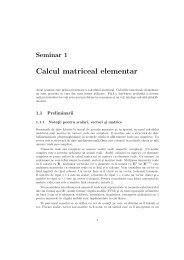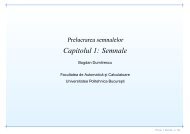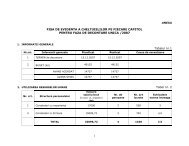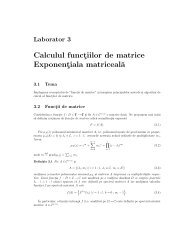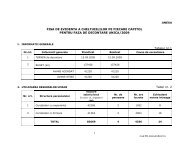- Page 1 and 2:
Capitolul 4 Calculul valorilor şi
- Page 3 and 4:
4.1. FORMULAREA PROBLEMEI 211 În a
- Page 5 and 6:
4.1. FORMULAREA PROBLEMEI 213 Exemp
- Page 7 and 8:
4.1. FORMULAREA PROBLEMEI 215 În c
- Page 9 and 10:
4.1. FORMULAREA PROBLEMEI 217 Pasul
- Page 11 and 12:
4.1. FORMULAREA PROBLEMEI 219 Demon
- Page 13 and 14:
4.1. FORMULAREA PROBLEMEI 221 de un
- Page 15 and 16:
4.1. FORMULAREA PROBLEMEI 223 Teore
- Page 17 and 18:
4.1. FORMULAREA PROBLEMEI 225 unita
- Page 19 and 20:
4.2. FORMA SCHUR 227 Exemplul 4.2 C
- Page 21 and 22:
4.2. FORMA SCHUR 229 Lema 4.2 (Defl
- Page 23 and 24: 4.2. FORMA SCHUR 231 unde S 11 ∈
- Page 25 and 26: 4.3. METODA PUTERII. METODA PUTERII
- Page 27 and 28: 4.3. METODA PUTERII. METODA PUTERII
- Page 29 and 30: 4.3. METODA PUTERII. METODA PUTERII
- Page 31 and 32: 4.4. ALGORITMUL QR 239 4.4 Algoritm
- Page 33 and 34: 4.4. ALGORITMUL QR 241 4.4.1 Reduce
- Page 35 and 36: 4.4. ALGORITMUL QR 243 prezentări
- Page 37 and 38: 4.4. ALGORITMUL QR 245 i.e. H k+1
- Page 39 and 40: 4.4. ALGORITMUL QR 247 Într-adevă
- Page 41 and 42: 4.4. ALGORITMUL QR 249 Se observă
- Page 43 and 44: 4.4. ALGORITMUL QR 251 B. Strategia
- Page 45 and 46: 4.4. ALGORITMUL QR 253 Teorema 4.15
- Page 47 and 48: 4.4. ALGORITMUL QR 255 nesingulară
- Page 49 and 50: 4.4. ALGORITMUL QR 257 Hessenberg a
- Page 51 and 52: 4.4. ALGORITMUL QR 259 cu H 11 ∈
- Page 53 and 54: 4.4. ALGORITMUL QR 261 4. [A(k : l,
- Page 55 and 56: 4.4. ALGORITMUL QR 263 not Consider
- Page 57 and 58: 4.4. ALGORITMUL QR 265 ⎡ H ← HU
- Page 59 and 60: 4.4. ALGORITMUL QR 267 structurală
- Page 61 and 62: 4.4. ALGORITMUL QR 269 5. S(k:k+1,k
- Page 63 and 64: 4.4. ALGORITMUL QR 271 4. % Triangu
- Page 65 and 66: 4.4. ALGORITMUL QR 273 elementelor
- Page 67 and 68: 4.4. ALGORITMUL QR 275 rotunjire ş
- Page 69 and 70: 4.4. ALGORITMUL QR 277 sau ( ρ ki
- Page 71 and 72: 4.4. ALGORITMUL QR 279 2. Pentru i
- Page 73: 4.5. CALCULUL VECTORILOR PROPRII 28
- Page 77 and 78: 4.5. CALCULUL VECTORILOR PROPRII 28
- Page 79 and 80: 4.6. CALCULUL SUBSPAŢIILOR INVARIA
- Page 81 and 82: 4.6. CALCULUL SUBSPAŢIILOR INVARIA
- Page 83 and 84: 4.6. CALCULUL SUBSPAŢIILOR INVARIA
- Page 85 and 86: 4.6. CALCULUL SUBSPAŢIILOR INVARIA
- Page 87 and 88: 4.6. CALCULUL SUBSPAŢIILOR INVARIA
- Page 89 and 90: 4.7. FORMA BLOC-DIAGONALĂ 297 cu m
- Page 91 and 92: 4.7. FORMA BLOC-DIAGONALĂ 299 Algo
- Page 93 and 94: 4.7. FORMA BLOC-DIAGONALĂ 301 În
- Page 95 and 96: 4.7. FORMA BLOC-DIAGONALĂ 303 4.7.
- Page 97 and 98: 4.7. FORMA BLOC-DIAGONALĂ 305 atun
- Page 99 and 100: 4.7. FORMA BLOC-DIAGONALĂ 307 Vers
- Page 101 and 102: 4.7. FORMA BLOC-DIAGONALĂ 309 O pr
- Page 103 and 104: 4.7. FORMA BLOC-DIAGONALĂ 311 În
- Page 105 and 106: 4.7. FORMA BLOC-DIAGONALĂ 313 rezu
- Page 107 and 108: 4.8. ALGORITMUL QR SIMETRIC 315 seo
- Page 109 and 110: 4.8. ALGORITMUL QR SIMETRIC 317 Not
- Page 111 and 112: 4.8. ALGORITMUL QR SIMETRIC 319 mul
- Page 113 and 114: 4.8. ALGORITMUL QR SIMETRIC 321 3.
- Page 115 and 116: 4.8. ALGORITMUL QR SIMETRIC 323 ele
- Page 117 and 118: 4.8. ALGORITMUL QR SIMETRIC 325 Pen
- Page 119 and 120: 4.8. ALGORITMUL QR SIMETRIC 327 tri
- Page 121 and 122: 4.9. METODE ALTERNATIVE 329 egalit
- Page 123 and 124: 4.9. METODE ALTERNATIVE 331 supunem
- Page 125 and 126:
4.9. METODE ALTERNATIVE 333 Demonst
- Page 127 and 128:
4.9. METODE ALTERNATIVE 335 BISECT
- Page 129 and 130:
4.9. METODE ALTERNATIVE 337 operaţ
- Page 131 and 132:
4.9. METODE ALTERNATIVE 339 ❅ ❅
- Page 133 and 134:
4.9. METODE ALTERNATIVE 341 1. Dac
- Page 135 and 136:
4.10. CONDIŢIONARE 343 ne propunem
- Page 137 and 138:
4.10. CONDIŢIONARE 345 constată i
- Page 139 and 140:
4.10. CONDIŢIONARE 347 condiţion
- Page 141 and 142:
4.10. CONDIŢIONARE 349 Pentru p =
- Page 143 and 144:
4.10. CONDIŢIONARE 351 F = A+E, cu
- Page 145 and 146:
4.10. CONDIŢIONARE 353 subspaţiul
- Page 147 and 148:
4.10. CONDIŢIONARE 355 În particu
- Page 149 and 150:
4.11. STABILITATE NUMERICĂ 357 de
- Page 151 and 152:
4.12. RUTINE LAPACK ŞI MATLAB 359
- Page 153 and 154:
4.13. PROBLEME 361 P 4.8 Fie λ 1,
- Page 155 and 156:
4.13. PROBLEME 363 P 4.25 Demonstra
- Page 157 and 158:
4.13. PROBLEME 365 P 4.43 Fie matri
- Page 159 and 160:
4.13. PROBLEME 367 P 4.59 Adaptaţi
- Page 161 and 162:
Capitolul 5 Descompunerea valorilor
- Page 163 and 164:
5.1. FORMULAREA PROBLEMEI 371 Demon
- Page 165 and 166:
5.1. FORMULAREA PROBLEMEI 373 ✻x
- Page 167 and 168:
5.1. FORMULAREA PROBLEMEI 375 Prin
- Page 169 and 170:
5.1. FORMULAREA PROBLEMEI 377 unde
- Page 171 and 172:
5.1. FORMULAREA PROBLEMEI 379 În s
- Page 173 and 174:
5.1. FORMULAREA PROBLEMEI 381 rela
- Page 175 and 176:
5.2. PROBLEME DE CALCUL CONEXE 383
- Page 177 and 178:
5.2. PROBLEME DE CALCUL CONEXE 385
- Page 179 and 180:
5.2. PROBLEME DE CALCUL CONEXE 387
- Page 181 and 182:
5.2. PROBLEME DE CALCUL CONEXE 389
- Page 183 and 184:
5.2. PROBLEME DE CALCUL CONEXE 391
- Page 185 and 186:
5.3. ALGORITMUL DVS 393 5.3 Algorit
- Page 187 and 188:
5.3. ALGORITMUL DVS 395 utilizaţi
- Page 189 and 190:
5.3. ALGORITMUL DVS 397 Comentarii.
- Page 191 and 192:
5.3. ALGORITMUL DVS 399 condiţia d
- Page 193 and 194:
5.3. ALGORITMUL DVS 401 ⎡ J ← U
- Page 195 and 196:
5.3. ALGORITMUL DVS 403 Având în
- Page 197 and 198:
5.3. ALGORITMUL DVS 405 suprascrier
- Page 199 and 200:
5.3. ALGORITMUL DVS 407 5. Dupăîn
- Page 201 and 202:
5.3. ALGORITMUL DVS 409 5. Dacă op
- Page 203 and 204:
5.4. CONDIŢIONARE 411 opt 1 opt 2
- Page 205 and 206:
5.4. CONDIŢIONARE 413 Demonstraţi
- Page 207 and 208:
5.5. STABILITATEA ALGORITMULUI DVS
- Page 209 and 210:
5.6. APLICAŢIILE DVS 417 problema
- Page 211 and 212:
5.6. APLICAŢIILE DVS 419 urmare,
- Page 213 and 214:
5.6. APLICAŢIILE DVS 421 şi de un
- Page 215 and 216:
5.6. APLICAŢIILE DVS 423 x, i.e. (
- Page 217 and 218:
5.6. APLICAŢIILE DVS 425 [ (A(i,:)
- Page 219 and 220:
5.6. APLICAŢIILE DVS 427 minimul a
- Page 221 and 222:
5.6. APLICAŢIILE DVS 429 5.6.4 Pro
- Page 223 and 224:
5.6. APLICAŢIILE DVS 431 Problema
- Page 225 and 226:
5.6. APLICAŢIILE DVS 433 Prin urma
- Page 227 and 228:
5.6. APLICAŢIILE DVS 435 se obţin
- Page 229 and 230:
5.6. APLICAŢIILE DVS 437 7. x ∗
- Page 231 and 232:
5.6. APLICAŢIILE DVS 439 2. Se cal
- Page 233 and 234:
5.8. PROBLEME 441 Dar ale matricei
- Page 235 and 236:
5.8. PROBLEME 443 are o soluţie un
- Page 237 and 238:
Capitolul 6 Calculul valorilor şi
- Page 239 and 240:
6.1. FORMULAREA PROBLEMEI 447 ( [ ]
- Page 241 and 242:
6.1. FORMULAREA PROBLEMEI 449 Propr
- Page 243 and 244:
6.2. FORMA SCHUR GENERALIZATĂ 451
- Page 245 and 246:
6.2. FORMA SCHUR GENERALIZATĂ 453
- Page 247 and 248:
6.3. ALGORITMUL QZ 455 6.3 Algoritm
- Page 249 and 250:
6.3. ALGORITMUL QZ 457 ⎡ (A,B)
- Page 251 and 252:
6.3. ALGORITMUL QZ 459 În cazul re
- Page 253 and 254:
6.3. ALGORITMUL QZ 461 i.e. acumula
- Page 255 and 256:
6.3. ALGORITMUL QZ 463 (H,T)←((Q
- Page 257 and 258:
6.3. ALGORITMUL QZ 465 5. Dacă opt
- Page 259 and 260:
6.3. ALGORITMUL QZ 467 construcţia
- Page 261 and 262:
6.3. ALGORITMUL QZ 469 Această sch
- Page 263 and 264:
6.3. ALGORITMUL QZ 471 5. Pentru k
- Page 265 and 266:
6.3. ALGORITMUL QZ 473 2. % Determi
- Page 267 and 268:
6.3. ALGORITMUL QZ 475 2. Se determ
- Page 269 and 270:
6.3. ALGORITMUL QZ 477 actuală. Pe
- Page 271 and 272:
6.3. ALGORITMUL QZ 479 (H,T)←(HZ
- Page 273 and 274:
6.3. ALGORITMUL QZ 481 6. H(:,n−2
- Page 275 and 276:
6.3. ALGORITMUL QZ 483 Algoritmul 6
- Page 277 and 278:
6.3. ALGORITMUL QZ 485 perechea (S,
- Page 279 and 280:
6.4. CALCULUL SUBSPAŢIILOR DE DEFL
- Page 281 and 282:
6.4. CALCULUL SUBSPAŢIILOR DE DEFL
- Page 283 and 284:
6.4. CALCULUL SUBSPAŢIILOR DE DEFL
- Page 285 and 286:
6.4. CALCULUL SUBSPAŢIILOR DE DEFL
- Page 287 and 288:
6.4. CALCULUL SUBSPAŢIILOR DE DEFL
- Page 289 and 290:
6.6. STABILITATEA ALGORITMULUI QZ 4
- Page 291 and 292:
6.8. PROBLEME 499 cu α, β paramet
- Page 293 and 294:
Indicaţii, răspunsuri, soluţii C
- Page 295 and 296:
INDICAŢII, RĂSPUNSURI, SOLUŢII 5
- Page 297 and 298:
INDICAŢII, RĂSPUNSURI, SOLUŢII 5
- Page 299 and 300:
INDICAŢII, RĂSPUNSURI, SOLUŢII 5
- Page 301 and 302:
INDICAŢII, RĂSPUNSURI, SOLUŢII 5
- Page 303 and 304:
INDICAŢII, RĂSPUNSURI, SOLUŢII 5
- Page 305 and 306:
INDICAŢII, RĂSPUNSURI, SOLUŢII 5
- Page 307 and 308:
INDICAŢII, RĂSPUNSURI, SOLUŢII 5
- Page 309 and 310:
INDICAŢII, RĂSPUNSURI, SOLUŢII 5
- Page 311 and 312:
INDICAŢII, RĂSPUNSURI, SOLUŢII 5
- Page 313 and 314:
INDICAŢII, RĂSPUNSURI, SOLUŢII 5
- Page 315 and 316:
INDICAŢII, RĂSPUNSURI, SOLUŢII 5
- Page 317 and 318:
INDICAŢII, RĂSPUNSURI, SOLUŢII 5
- Page 319 and 320:
INDICAŢII, RĂSPUNSURI, SOLUŢII 5
- Page 321 and 322:
INDICAŢII, RĂSPUNSURI, SOLUŢII 5
- Page 323 and 324:
INDICAŢII, RĂSPUNSURI, SOLUŢII 5
- Page 325 and 326:
Bibliografie [1] J.O. Aasen. On the
- Page 327 and 328:
BIBLIOGRAFIE 535 [31] S. Haykin. Ad
- Page 329 and 330:
Index acurateţe, 13 algoritmi la n
- Page 331 and 332:
INDEX 539 hermitică, 49, 215 Hesse
- Page 333:
INDEX 541 a algoritmului QR, 356 a


